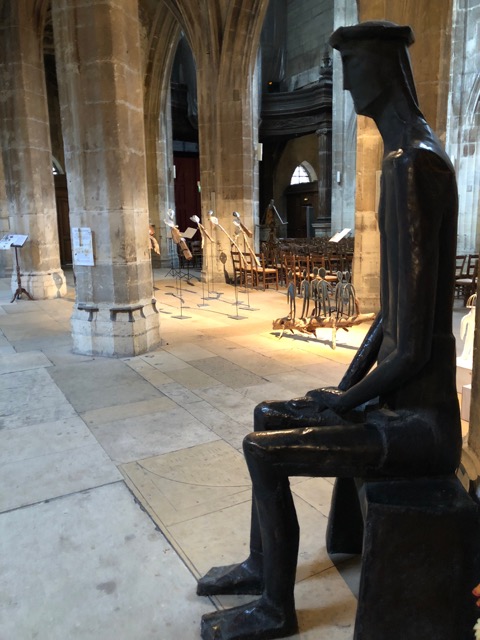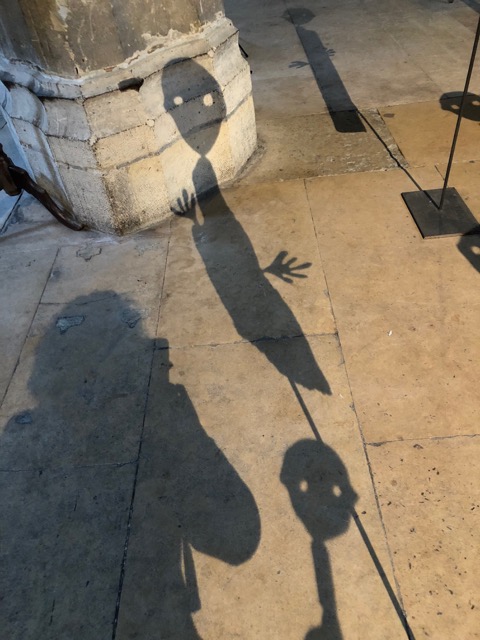I’m always surprised and gratified and fascinated and ever so grateful to this community when I post something tentative and somewhat vulnerable, when I’m thinking out loud, as it were — and then, as with Wednesday’s post, a conversation builds that is rich and varied and thoughtful and illuminating and honest. If you haven’t already, I hope you might find time to read through post and comments and, perhaps, to add your own.
I, however, am still guarding my right arm — improving, but still tender — and we’re having friends visit for lunch, so I’ve a bit of tidying and stirring to do. I’ve answered many of your comments, but probably won’t get to more of them until much later today. Meanwhile, do feel free to chat amongst yourselves.
First, though, I thought I’d share these photos taken in Paris last November in a wonderful old church — very bare of ornamentation and awaiting/undergoing restoration– I discovered about a decade ago, when Eric Tennin posted a photo of this statue on his much loved, but now defunct, blog ParisDailyPhoto

The sculpture, by Pierre de Grauw, is titled Le Christ aux Outrages, or Christ, Mocked, and in an artist’s note taped up nearby, de Grauw compares this representation of Christ to another sculpture beside it in his studio — in that sculpture, a man cried out “with all his forces his indignation and revolt.” The sculptor goes on to say that he discovered that those two sculptures were equally religious, that Jesus also cried out against inhumanity, that Jesus wasn’t afraid to raise his voice against those who made others suffer in unjustifiable ways.
But, de Grauw points out, when he suffers himself, Christ retreats into silence. This is Christ Mocked [Le Christ Aux Outrages and Christ Mocked are iconic moments in Christ’s life and suffering, represented and well known in Christian art — generally including a Crown of Thorns], the sculptor tells us: majestic, dignified, peaceful, and grown/enlarged/amplified by an unsuspected inner strength.

I haven’t visited St. Merri for quite a few years, although I’ve been nearby for exhibitions at the Pompidou Centre or enroute to the Marais. But I’d walked from the 6th to the 5th and then over the Seine that rainy Paris morning to check out the charming stationery shop — L’Ecritoire — that had begun carrying my friend’s whimsical cards featuring the doings of Wiston the Mouse and his friend Otis.
That delightful shop (oh, the tempting treasures!) turned out to be just across the street from St. Merri. Of course, I took the opportunity to renew acquaintance with this sombre and beautiful and meditative work of art, its insistence on the true meaning of Christianity.
And was met with another powerful prompt to think about what Christianity should or could mean in this work by Haude Bernabé entitled #marenostrum — Our Sea, in Latin, referring to the Mediterranean. Bernabé’s installation was conceived after the 2013 tragedy in which 366 mostly African migrants died when the ship carrying them from Libya to Italy sank off the island of Lampedusa.

In response to that tragedy, the Italian Prime Minister Enrico Letta used the ancient term “Mare Nostrum” for the Mediterranean as he put into action a plan for the European community to come to grips with increased immigration.

Inspired by Letta’s commitment, Bernabé — at least as I understand from a quick reading of this article — began working on a “cri de coeur dont la forme est artistique” (a cry from the heart, whose form is artistic). The hope (or even belief) here is that Art might have the power to let people see that Europe cannot remain a fortress and the the Mediterranean must not be a cemetery.

And that rather than closing borders, a politics of opening to the Other is needed “Plutôt que de fermer les frontières, une politique d’ouverture à l’autre semble nécessaire.”

I will say no more (my arm is beginning to cry aloud, though — keyboarding does not seem to be what it wants to do right now)

but leave you to walk around this moving installation on your own. . .



Finally, it felt only right to implicate myself directly in this installation. . .

I can see, as I finish this post, that I’ve ended on rather too sombre a note for a Friday. Tant pis, quite honestly, is all I can muster in response. The sombre exists, and if Art makes it disturbingly beautiful for us, we are fortunate that we must only contemplate — rather than experience (not only contemplate, perhaps, but my right arm is not prepared to suggest action other than loosely gesturing toward the UNHCR).
And on that note, I wave best weekend wishes to all of you and look forward to reading your comments here and on Wednesday’s (and any earlier) posts. xo
The message is so powerful! A sign that I saw recently: When we have plenty, we need to build a longer table not a higher wall. If "the New World" had not accepted the hungry, those needing a safe place and those looking for new opportunities, most of us would not be here. I hope that your arm is feeling better soon. Enjoy your guests.
What a beautiful sentence,Madame La-bas!
Dottoressa
I agree with Dottoressa. And even when we don't have plenty — or don't feel/think we have enough — I hope we remember our shared humanity.
Beautifully stated " longer table not a higher wall"
These sculptures are as poignant as Rodin's Burghers of Calais, especially in such a haunting and holy setting.
My kid has for the last two summers taken a photography class that has turned out to be full of refugees. The past year they were from Mali and Guinea; the year before from Chechnya. I definitely have noticed a sudden increase in Africans in town, but I kind of look for them because I lived in Africa for two years and am always eager to practice my Swahili. I am sure others have noticed the influx, too, and with less excitement than me. But the European colonialists are responsible at the heart of it–they pillaged the continent, then installed puppet regimes, then, in the face of independence, constructed trade deals that gave the poor countries, with little bargaining power, short shrift. And we are surprised when people flee the poverty and dictatorships? You cannot create chaos at your neighbor's house and then think that you will sleep quietly at night.
Meanwhile, if you want a lighthearted take on borders and the end of borders, see the movie "Rien à Déclarer" (Nothing to Declare) with the adorable Dany Boon and the utterly insane Benoît Poelvoorde, who is kind of a francophone (well, Belgian) Robin Williams. It's about the 1993 end of EU borders thanks to the Schengen treaty. Hilarious.
I remember reading about your kid taking that course — I suspect that might be a defining part of their education. (having a mother who learned to speak Swahili and is as aware of colonial history/politics will be a significant factor as well! 😉
I'll look for that film — thank you!
As one who spent almost 30 years of my professional life in service to refugees, this exhibition truly hits home. When I started refugee work, the US admitted over 130k refugee annually. In FY2018, only 22,491 were admitted; 4k fewer even than were allowed when admissions were tightened in the year after the 9/11 attack. Fewer still, will be allowed in FY2019 even though refugees coming to this country go through extensive, multiple background and medical checks by government agencies that can take up two years. All due to this administration's small-minded, nationalistic, and hateful fear mongers.
I thank you for the photos and background info of Bernabé's art. In site trips to resettlement agencies across the country, I visited refugees in their homes–was warmly welcomed and profusely thanked for helping them. Honored, and yet horribly saddened to hear their often gruesome stories of survival in desperate circumstances. Listened to their happiness that their children now had access to an education. When we lose touch with our compassion and empathy, when we deny access to those who have little and need much, we diminish ourselves and our country. Bernabé has captured the pathos, the plight and the flight of refugees so well in his exhibition.
Brava, Mary, and thank you for the work you've done helping refugees resettle. How hard it must be to work in this field now. Let us continue to hope that art like Bernabé's "raises consciousness" (to use that 60s term) so that we might all keep our shared humanity at the forefront of our political choices/actions.
Moving….
We need more Bernabés and Wei Wei-s,until some would hear,see and understand
Dottoressa
Best wishes for your hand
Exactly!
Those bare black figures, balancing precariously on their little trunk across the open space – the image breaks my heart. And things are getting worse and worse in the “Mare Nostrum”. Letta’s initiative was truncated. Nowadays, the private boats which try to save castaways in danger of drowning are banned from entering harbors in Italy, Malta, or France. It took the countries of Europe several weeks to decide on how to distribute 33(!) desperate refugees. Yes, we carry golden cages for heads and do not venture to look beyond the bars.
Yes, it is heart-breaking, and I know that Letta's initiative was only allowed a year. . .
Very beautiful.
Isn't it?!
Wonderful. I'm going to walk about that installation again. Thank you for sharing it.
Back again to say that I just read Wednesday's post and all the comments and your very thoughtful replies. Love that you're finding your way through the morass that is life at our age. Particularly love that in one of your replies you try to reassert the role of the blogger as a facilitator of conversation, and the post as not necessarily a means to solicit solutions from readers, but instead as a narration of the blogger's own problem solving process to be viewed as possible fodder for contemplation.
Hope your hand feels better today. If not don't bother to reply to my comment. Just nod and smile. 🙂
Thanks, Sue. It's a rich conversation over there, isn't it? We all seem to find challenges of the changes that accompany this age (some positive challenges; some less so) which perhaps are eased somewhat in the sharing.
I've not heard of Pierre de Grauw or Haude Bernabe. So thank you for the introduction to their works…very powerful and also beautiful. Take care of your hand. Hope it's getting plenty of rest today. ~Amelia
You're very welcome, Amelia. I felt very fortunate to have found them.